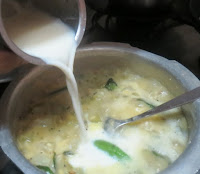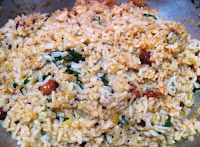Snake Gourd/Padavalakai is one of the healthy vegetable you get al around the year. Many many preparations can be done using this Snake gourd. It is also called as Padavalakai in Kannada. (Karnataka - India). We do prepare sweet curry, dry curry, and Kalasu (coconut jeera mix curry) and even payasa/kheer is prepared using Padavalkai
I have used Padavalaki, moong dal, ginger and some spices. I have added little milk.
Adding milk to the curry helps to enhance the taste and aroma. I have seen one of my Sri Lankan friend adding milk instead of coconut milk.
Let us see some benefits of eating "Snake Gourd" in our diet.
Snake gourd is good for detoxifying the body. It is said that it reduces the fever, improve the digestion, and helps to strengthen the immune system. It also helps in treating the dieabetes, boost strength adn good for hair and weight loss. It is loaded with nutrients, vitamins and minerals which are essential for our health. It contain good amount of dietary fiber and good for people who suffer from constipation. It is low in calories and is rich with protein. It is loaded with Vitamin A, B, and Vitamin C. It has minerals like manganese, magnesium, calcium, iron, potassium and iodine.
It is an easy dish and anyone can try. Snake Gourd Dal goes well with all type of rotis, naans, plain rice or any spicy rice.
No Onion or No Garlic in this " Snake Gourd Dal ".
I have used pressure cooker to cook.
Snake Gourd : 2 Small ones.
Moong Dal : 1/2 Cup (2 Handful)
Ginger : An inch
Green Chilly : 2
To Add :
Jeera/Cumin Seeds Seasoning : 1 Teaspoon
Fresh Milk : 1/2 Cup
Coriander Leaves : 2 Tablespoons
Salt : As required
Turmeric Powder : A pinch
Lemon : 1/2 Potion
Seasoning :
Oil : 1 Teaspoon
Red chilly : 1
Curry Leaves : 5 to 6 leaves
Ingh : A pinch
2. Remove inner pulp from snake gourd. Cut snake gourd and coriander leaves in to small. 3. Wash moong dal and keep it aside. Slit green chilly in the middle.
4. Wash and remove the outer layer of ginger and wash it again. Grate it and keep it aside.
5. Put snake gourd, washed moong dal, green chilly and grated ginger in a small pressure cooker.
6. Add littel turmeric powder and 1/2 cup of water and close the lid.
7. Put weight and cook for 6 to 8 minutes. Put off the fire. Let it cool.
7. Put weight and cook for 6 to 8 minutes. Put off the fire. Let it cool.
8. Open the lid. Mix the ingredients and add 1 cup of water.
9. Add salt and mix it well. Let it cook for 2 minutes.
10. Add jeera/cumin seeds seasoning. Add milk and cook on low flame for a minute.
11. Add lemon juice and shift the dal to a seriving dish. Add a spoon of ghee before serving.
12. Add coriander leaves and serve with the main dish.
Time : 30 Minutes
Serves : 3 to 4 .
I have used Padavalaki, moong dal, ginger and some spices. I have added little milk.
Adding milk to the curry helps to enhance the taste and aroma. I have seen one of my Sri Lankan friend adding milk instead of coconut milk.
Let us see some benefits of eating "Snake Gourd" in our diet.
Snake gourd is good for detoxifying the body. It is said that it reduces the fever, improve the digestion, and helps to strengthen the immune system. It also helps in treating the dieabetes, boost strength adn good for hair and weight loss. It is loaded with nutrients, vitamins and minerals which are essential for our health. It contain good amount of dietary fiber and good for people who suffer from constipation. It is low in calories and is rich with protein. It is loaded with Vitamin A, B, and Vitamin C. It has minerals like manganese, magnesium, calcium, iron, potassium and iodine.
It is an easy dish and anyone can try. Snake Gourd Dal goes well with all type of rotis, naans, plain rice or any spicy rice.
No Onion or No Garlic in this " Snake Gourd Dal ".
I have used pressure cooker to cook.
Things Needed :
To Cook :Snake Gourd : 2 Small ones.
Moong Dal : 1/2 Cup (2 Handful)
Ginger : An inch
Green Chilly : 2
To Add :
Jeera/Cumin Seeds Seasoning : 1 Teaspoon
Fresh Milk : 1/2 Cup
Coriander Leaves : 2 Tablespoons
Salt : As required
Turmeric Powder : A pinch
Lemon : 1/2 Potion
Seasoning :
Oil : 1 Teaspoon
Red chilly : 1
Curry Leaves : 5 to 6 leaves
Ingh : A pinch
Method :
1. Wash and cut Snake gourd, coriander leaves and curry leaves.2. Remove inner pulp from snake gourd. Cut snake gourd and coriander leaves in to small. 3. Wash moong dal and keep it aside. Slit green chilly in the middle.
4. Wash and remove the outer layer of ginger and wash it again. Grate it and keep it aside.
5. Put snake gourd, washed moong dal, green chilly and grated ginger in a small pressure cooker.
6. Add littel turmeric powder and 1/2 cup of water and close the lid.
7. Put weight and cook for 6 to 8 minutes. Put off the fire. Let it cool.
7. Put weight and cook for 6 to 8 minutes. Put off the fire. Let it cool.
8. Open the lid. Mix the ingredients and add 1 cup of water.
9. Add salt and mix it well. Let it cook for 2 minutes.
10. Add jeera/cumin seeds seasoning. Add milk and cook on low flame for a minute.
11. Add lemon juice and shift the dal to a seriving dish. Add a spoon of ghee before serving.
12. Add coriander leaves and serve with the main dish.
Note :
Do not over cook. You can cook separately. (Not necessary to use pressure cooker). Adding milk is optional. You can use coconut milk instead of milk. Adding onions and garlic is optional. Adding more spice is optional. Adding ghee is optional.Time : 30 Minutes
Serves : 3 to 4 .




















